| |
 We
structured our two-week trip so that our 12 days of actual birding
would be divided between three localities: one or more sites in the
Atlantic lowlands (5 days), the high mountains (3 days), and the
Pacific lowlands (4 days). We
structured our two-week trip so that our 12 days of actual birding
would be divided between three localities: one or more sites in the
Atlantic lowlands (5 days), the high mountains (3 days), and the
Pacific lowlands (4 days).
Our visit to the
Caribbean slope centered around the famed La Selva Biological Reserve
(sign) but we saved a lot of money by staying elsewhere. This decision
had mixed results because now we were required to hire a guide to enter
the Reserve. The guided trips were very expensive (especially the
privately guided ones, as we chose) so our actual time in the forest
was substantially limited. Only the entrance road into La Selva and the
entrance clearing was free.
|
On
17 December we spent our time along the entrance road and headquarters
clearing, until a mid-day downpour wiped out further birding. Even
these habitats were productive, including superb views of Broad-billed Motmot (right) along the entrance road. We had lunch at La Selva's cafeteria and watched the clearing as the rain came down. Golden-hooded Tanager
(below left) foraged in the fruiting bushes along the sidewalk, as did
an assortment of other species, including Common Tody-Flycatcher,
Bright-rumped Atila, and Paltry Tyrannulet, while wintering Northern
Waterthrush walked through the grass.
The
clearing was also a fine spot to watch toucans flying over or perching
atop the tallest forest trees, both the noisy Chestnut-mandibled and
the less common Keel-billed. For a brief time around noon on 17 Dec, a
male Snowy Cotinga (below right), a much-wanted species, perched atop a bare tree in the forest-edge canopy. |
|
|
|
|
|
| The
main birding, though, starts in the lowland rain forest across the wide
and swift Puerto Viejo River (above). On 18 December we arranged for a
guided walk, starting at dawn, and crossed the suspension bridge (below
left) into the jungle, with our guide Kenneth Alfonso (below right).
Quite to our surprise, many of the trails at La Selva are paved or nice
boardwalks, even deep into the forest. |
|
|
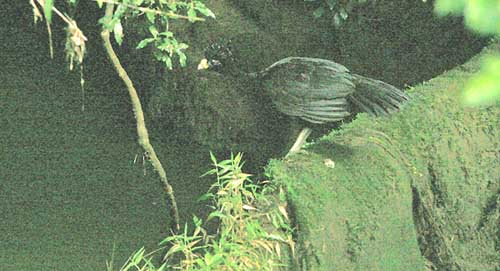 The
walk was a success for me right away, because as we crossed the bridge
and looked down into the shadows of the riverbank, we saw a male Great Curassow
(right) perched on a huge log. The spot was so dark and the distance so
great that my flash barely penetrated, and I've had to lighten this
shot substantially in PhotoShop, which gives it that grainy, almost
impressionistic feeling. The huge turkey-sized bird then flew across
the river and into the forest. The
walk was a success for me right away, because as we crossed the bridge
and looked down into the shadows of the riverbank, we saw a male Great Curassow
(right) perched on a huge log. The spot was so dark and the distance so
great that my flash barely penetrated, and I've had to lighten this
shot substantially in PhotoShop, which gives it that grainy, almost
impressionistic feeling. The huge turkey-sized bird then flew across
the river and into the forest. |
 |
We saw a good selection of birds on our two walks with Kenneth, including a White-necked Puffbird
(left) sitting in the canopy next to a huge bromeliad. We also had two
species of monkey, an agouti, peccaries, and poison-dart frogs, photos
of which are elsewhere on this site. But by far the highlight was
perched in the compound across the river, and spotted by Kenneth: a
young Ornate Hawk-Eagle (below). When the word was spread via radio, a dozen other workers and guides came running to see this rarely-seen species. |
|
|
| |
 We stayed a couple miles away from La Selva at a very reasonably priced bed & breakfast, Posada Andrea Christina,
at the edge of Puerto Viejo de Sarapiqui. We had a lovely private
bungalow (right) and breakfast is served in a roofed but open-sided
cabana in the garden (below left), right next to the feeders. The owner
is Alex Martinez (below right), who is very knowledgeable about natural
history subjects. He and his son Kevin are available as guides and
drivers, schedule permitting, and we even arranged for a pickup at the
San Jose airport. The grounds held a sloth (see mammal page) and the feeders were great for photographing birds (a gallery is below). We stayed a couple miles away from La Selva at a very reasonably priced bed & breakfast, Posada Andrea Christina,
at the edge of Puerto Viejo de Sarapiqui. We had a lovely private
bungalow (right) and breakfast is served in a roofed but open-sided
cabana in the garden (below left), right next to the feeders. The owner
is Alex Martinez (below right), who is very knowledgeable about natural
history subjects. He and his son Kevin are available as guides and
drivers, schedule permitting, and we even arranged for a pickup at the
San Jose airport. The grounds held a sloth (see mammal page) and the feeders were great for photographing birds (a gallery is below). |
|
|
|
Clay-colored Robin (above)
male Passerini's Tanager (below)
|
Black-cheeked Woodpecker (above)
female Passerini's Tanager (below)
|
|
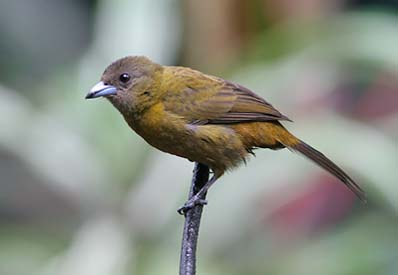 |
|
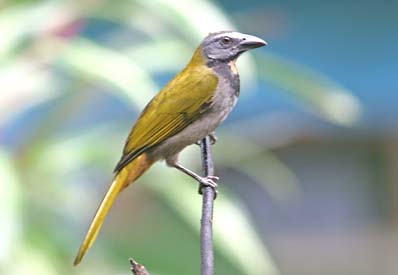 |
male Shining Honeycreeper (above) |
Buff-throated Saltator (above) |
|
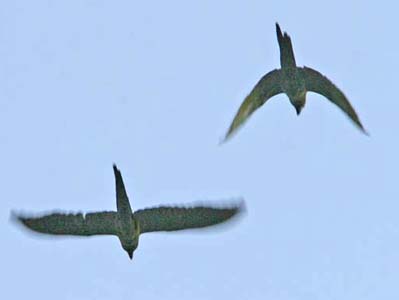 There
are open farm fields mixed with riparian corridors across the road from
Posada Andrea Christina, and we also visited nearby farms with Kevin.
Here we walked at dusk to some huge wild almond trees that had
attracted a pair of Great Green Macaw (right), a
species we had very much hoped to see. Alex Martinez has been in the
forefront of the conservation movement for this macaw locally,
including purchasing rights to nest-trees so that the nest is not
disturbed. There
are open farm fields mixed with riparian corridors across the road from
Posada Andrea Christina, and we also visited nearby farms with Kevin.
Here we walked at dusk to some huge wild almond trees that had
attracted a pair of Great Green Macaw (right), a
species we had very much hoped to see. Alex Martinez has been in the
forefront of the conservation movement for this macaw locally,
including purchasing rights to nest-trees so that the nest is not
disturbed.
During our days in the Caribbean lowlands, we engaged Alex or Kevin to drive us up into the foothills to visit Braulio Carrillo National Park
(the mountains shown in the photo below, from which the Susio River
springs, are part of that park); the small abandoned gardens at 'El Tapir' (a fine hummingbird spot); and the feeders at Mirador Cinchona, up on the slopes of Volcan Poas. The latter two sites are featured prominently on the hummingbird page of this trip report. |
|
|
|


 The
walk was a success for me right away, because as we crossed the bridge
and looked down into the shadows of the riverbank, we saw a male Great Curassow
(right) perched on a huge log. The spot was so dark and the distance so
great that my flash barely penetrated, and I've had to lighten this
shot substantially in PhotoShop, which gives it that grainy, almost
impressionistic feeling. The huge turkey-sized bird then flew across
the river and into the forest.
The
walk was a success for me right away, because as we crossed the bridge
and looked down into the shadows of the riverbank, we saw a male Great Curassow
(right) perched on a huge log. The spot was so dark and the distance so
great that my flash barely penetrated, and I've had to lighten this
shot substantially in PhotoShop, which gives it that grainy, almost
impressionistic feeling. The huge turkey-sized bird then flew across
the river and into the forest. 
 We stayed a couple miles away from La Selva at a very reasonably priced bed & breakfast, Posada Andrea Christina,
at the edge of Puerto Viejo de Sarapiqui. We had a lovely private
bungalow (right) and breakfast is served in a roofed but open-sided
cabana in the garden (below left), right next to the feeders. The owner
is Alex Martinez (below right), who is very knowledgeable about natural
history subjects. He and his son Kevin are available as guides and
drivers, schedule permitting, and we even arranged for a pickup at the
San Jose airport. The grounds held a sloth (see mammal page) and the feeders were great for photographing birds (a gallery is below).
We stayed a couple miles away from La Selva at a very reasonably priced bed & breakfast, Posada Andrea Christina,
at the edge of Puerto Viejo de Sarapiqui. We had a lovely private
bungalow (right) and breakfast is served in a roofed but open-sided
cabana in the garden (below left), right next to the feeders. The owner
is Alex Martinez (below right), who is very knowledgeable about natural
history subjects. He and his son Kevin are available as guides and
drivers, schedule permitting, and we even arranged for a pickup at the
San Jose airport. The grounds held a sloth (see mammal page) and the feeders were great for photographing birds (a gallery is below). 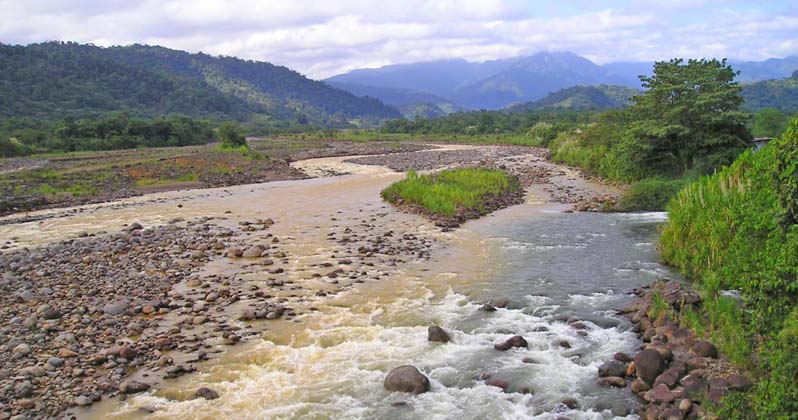
 We
structured our two-week trip so that our 12 days of actual birding
would be divided between three localities: one or more sites in the
Atlantic lowlands (5 days), the high mountains (3 days), and the
Pacific lowlands (4 days).
We
structured our two-week trip so that our 12 days of actual birding
would be divided between three localities: one or more sites in the
Atlantic lowlands (5 days), the high mountains (3 days), and the
Pacific lowlands (4 days). 


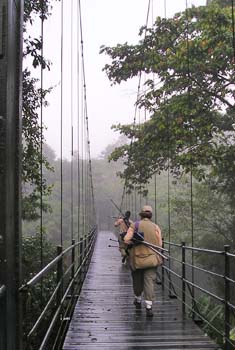
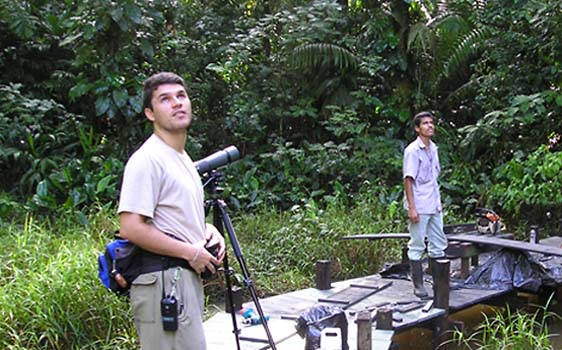

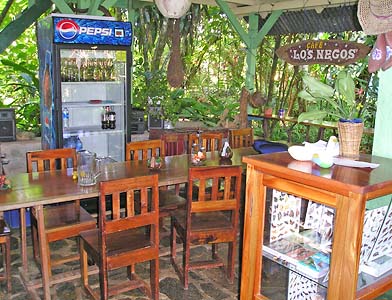
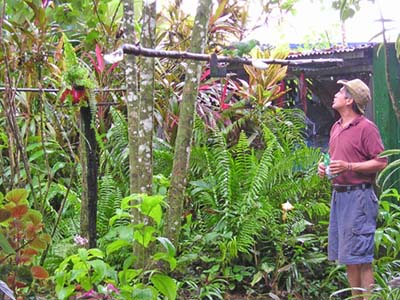
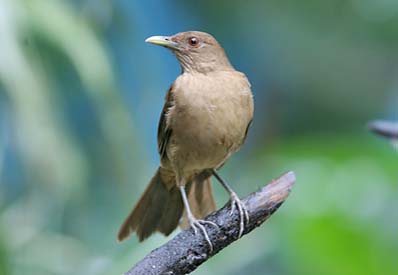
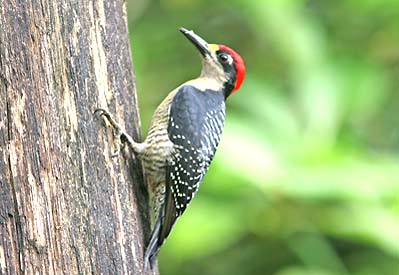
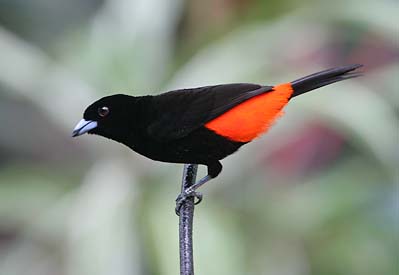

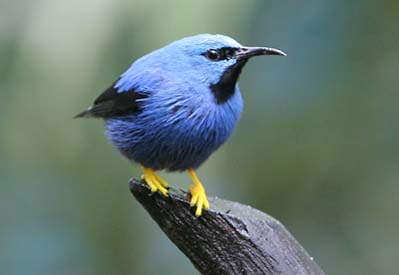

 There
are open farm fields mixed with riparian corridors across the road from
Posada Andrea Christina, and we also visited nearby farms with Kevin.
Here we walked at dusk to some huge wild almond trees that had
attracted a pair of Great Green Macaw (right), a
species we had very much hoped to see. Alex Martinez has been in the
forefront of the conservation movement for this macaw locally,
including purchasing rights to nest-trees so that the nest is not
disturbed.
There
are open farm fields mixed with riparian corridors across the road from
Posada Andrea Christina, and we also visited nearby farms with Kevin.
Here we walked at dusk to some huge wild almond trees that had
attracted a pair of Great Green Macaw (right), a
species we had very much hoped to see. Alex Martinez has been in the
forefront of the conservation movement for this macaw locally,
including purchasing rights to nest-trees so that the nest is not
disturbed.